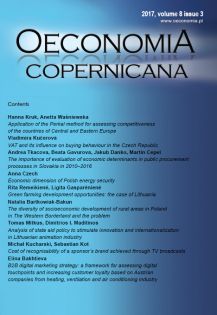Application of the Perkal method for assessing competitiveness of the countries of Central and Eastern Europe
Application of the Perkal method for assessing competitiveness of the countries of Central and Eastern Europe
Author(s): Hanna Kruk, Anetta WaśniewskaSubject(s): Supranational / Global Economy, Economic development, Socio-Economic Research
Published by: Instytut Badań Gospodarczych
Keywords: competitiveness; CEE economies; Perkal method;
Summary/Abstract: Research background: The changes that took place in the late twentieth century led to the transformation of the political system in the countries of Central and Eastern Europe (CEE). As a result, there has been an increase in the competitiveness of some of the economies among the CEE states. Due to different priorities and goals, these countries are also characterized by different levels in socio-economic development. Purpose of the article: The aim of the article is to identify the determinants affecting the competitiveness among the selected CEE countries. Methods: Based on Eurostat data, a set of determinants affecting competitiveness was established. A number of determinants have been eliminated in relation to the variation coefficient. At the same time, a classification of the level of competitiveness among the CEE countries has been made by using the Perkal method. The analysis used 14 selected indicators, 10 of which are considered as stimulating, and 4 as deteriorating the competitiveness of national economies. The result led to obtaining a synthetic level indicator of potential of the CEE countries. Findings & Value added: Following the findings of the conducted analysis, the highest economic competitiveness exists in Estonia and in the Czech Republic, while the lowest was found in Romania and Bulgaria. The results of the evaluation obtained with the Perkal method concerning the competitiveness of the CEE countries that belong to the EU are largely consistent with those presented in different global competitiveness rankings. However, the method applied in this article seems much simpler and less time-consuming, allowing at the same time an optimal choice of analytical determinants. The selected linear Pearson correlation’s coefficient confirmed that there is a strong positive relationship between the designated values of the synthetic indicator of competitiveness and the GDP per capita. This confirms the validity of test method used.
Journal: Oeconomia Copernicana
- Issue Year: 8/2017
- Issue No: 3
- Page Range: 337-352
- Page Count: 16
- Language: English

